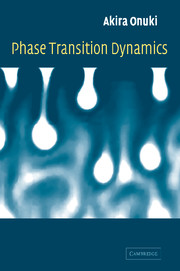7 - Dynamics in polymers and gels
Published online by Cambridge University Press: 13 August 2009
Summary
We will first give a theory of viscoelastic dynamics in polymeric binary systems, where a new concept of dynamic stress–diffusion coupling will be introduced in the scheme of viscoelastic two-fluid hydrodynamics. A Ginzburg–Landau theory of entangled polymer solutions will also be presented, in which chain deformations are represented by a conformation tensor. The reptation theory for entangled polymers will be summarized in Appendix 7A. We will also present a Ginzburg–Landau theory of gels to discuss dynamics and heterogeneities inherent to gels.
Viscoelastic binary mixtures
Entanglements among polymer chains impose severe topological constraints on the molecular motions. Their effects on polymer dynamics are now well described by the reptation theory in a surprisingly simple manner [1, 2]. In such systems, the stress relaxation takes place on a very long timescale τ (which should not be confused with the reduced temperature in near-critical systems). This means that a large network stress arises even for small deformations. If the timescale of the deformations is shorter than τ, the system behaves as a soft elastic body or gel. If it is longer than τ, we have a very viscous fluid.
In polymeric mixtures, it is highly nontrivial how the network stress acts on the two components and how it influences spatial inhomogeneities of the composition in various situations [3]–[5]. In this section we will introduce a mechanism of dynamical stress–diffusion coupling, which has recently begun to be recognized.
- Type
- Chapter
- Information
- Phase Transition Dynamics , pp. 317 - 370Publisher: Cambridge University PressPrint publication year: 2002



